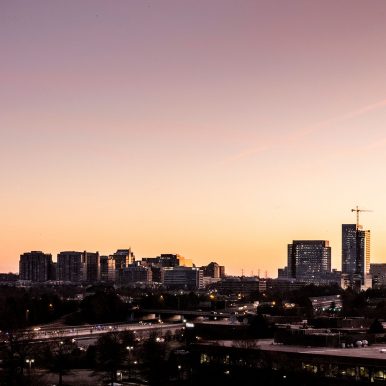Kicking the can
Va. companies delay decisions about office space
Robyn Sidersky //February 27, 2022//
Kicking the can
Va. companies delay decisions about office space
Robyn Sidersky //February 27, 2022//
In April 2020, Savan Group LLC, a federal contractor specializing in digital transformation, information technology and management consulting, gave up its 10,500-square-foot office space in Tysons.
Like many other companies, Savan Group shifted to remote work due to the COVID-19 pandemic, but by summer 2021, company President and CEO Veeral Majmudar was ready to look at returning workers to the office.
“Being in the consulting business … some level of engagement amongst our colleagues was important,” Majmudar says. “That’s how our business thrives — the sharing of ideas and communication. And while we can do a lot of that virtually, you do lose a little bit when you’re not able to meet in person.”
Working with leasing agency Ethos Tenant Co., Majmudar found a “plug-and-play,” fully furnished 17,500-square-foot office in Tysons that Savan Group secured via sublease at a steeply discounted rate.
It was an “opportunistic” move made possible by shifting dynamics of the commercial real estate market as many companies are “shifting and downsizing,” he says.
More than two years after the pandemic upended working norms, Virginia companies continue to reevaluate their commercial real estate needs. It’s been a slow and sometimes frustrating process. Just when some companies have been ready to return workers to the office, even on a hybrid basis, COVID-19 has surged, throwing a wrench into long-term plans. The pivot to hybrid and remote work, now a permanent fixture for many companies, has had landlords and tenants scrambling to figure out how it will impact the office market.

More empty space in 2021
Real estate experts say Virginia had higher vacancy rates in 2021, compared with the previous year. Available office space averaged 12.4% for 2021, up from 11.3% in 2020 and around 11% prior to the pandemic in 2019, according to Lisa Sturtevant, chief economist for Virginia Realtors, citing data from Washington, D.C. -based commercial real estate analytics company CoStar Group Inc.
It’s not an unexpected situation, she says.
“Businesses didn’t have the opportunity to vacate their office space until their leases were over, so they were locked in [during] 2020,” Sturtevant says. And as the pandemic persisted, she explains, companies were able to exit or renegotiate leases.
Statewide, office net absorption (total square feet leased per year minus square feet vacated) was negative for six consecutive quarters, starting in the third quarter of 2020 and lasting through 2021, according to a Virginia Realtors report.
The leasing picture also varies by region.
Northern Virginia, the state’s largest market, had about 36 million square feet of vacant office space at the end of 2021. That’s about 15.7% of the region’s total 229 million square feet of office space — around a percentage point higher than 2020. Prestigious Class A office space accounts for half of NoVa’s office space and had a vacancy rate of 19% last year, compared with about 17.5% in 2020. Aside from the pandemic, Sturtevant says, another factor continuing to impact Northern Virginia’s elevated vacancy rate is the military’s 2005 Base Realignment Closure (BRAC) plan, which resulted in some military agencies and associated contractors vacating leased office space in the region.
Richmond’s office market, on the other hand, bounced back faster than Northern Virginia’s during 2021, Sturtevant says.
Many downtown Richmond businesses have ties to state government, where working in person was more important, she says. As a result, vacant office space has increased less than a percent year-over-year to 6.7% but remained higher than the 2019 vacancy rate of 5.6%, according to Amy Broderick, Richmond-based senior vice president with Cushman & Wakefield | Thalhimer.
Leasing activity is rebounding in Richmond, says Komail Khaja, Colliers’ director of research for Central and Southeast Virginia. In 2020, about half the leases in Richmond were new and a third were renewals, but 2021 saw the inverse. A lot of space that has come on the market, including subleased space, has been backfilled, he notes.
Broderick says that significantly more companies vacated office space in Richmond during 2020 and 2021 compared with 2019, likely due to pandemic-related downsizing and remote work.
David Wilkins, Richmond-based executive vice president and principal with Colliers Mid-Atlantic, is optimistic that the Richmond market will begin to accelerate in the next 12 to 24 months. Most markets in Virginia are “quite healthy,” with smaller markets facing supply constraints with less than 5% vacancy, he says. “Consistent across the commonwealth,” he notes, “smaller local and regional firms are back in the office.”
Hampton Roads ended 2021 with an office space vacancy rate of about 8%, higher than its pre-pandemic rate in 2019 of 7.5%, but still below the 2021 national average of about 12%, according to Rob Sult, Harvey Lindsay Commercial Real Estate brokerage associate, citing CoStar Group data.
Sult’s optimistic that office space performance will improve across the Hampton Roads market, but cautions, “If we have another outbreak … [and] if we go backwards again, then all bets are off.”

Murky future
Landlords are bending over backward to lure tenants, offering everything from flat rental rates to several months of free rent to shorter leases and above-market tenant improvement allowances. “There’s a pretty big share of businesses that are looking for ways to change up their office space to make it more attractive,” Sturtevant says.
While some industries may move to completely remote work or downsize with hybrid work, companies requiring office space are seeking locations with significant amenities to draw employees back to the office.
“Who wants to leave their house if they have their kitchen and their gym and their bed and their couch and a TV?” asks Rachel Salasky, a Virginia Beach-based associate with Divaris Real Estate Inc. “Landlords are needing to find a way to make their office buildings something exciting to come to.”
For the commercial real estate industry, predicting when or if workers will return to offices in larger numbers can feel like a guessing game.
Two major Virginia employers have already made the shift to hybrid work. McLean-based Capital One Financial Corp. delayed its return to in-office work at least two times before giving up on a specific date at the end of 2021. Similarly, Richmond-based Dominion Energy Inc. adopted a hybrid and remote working policy for roughly one-third of its employees. Federal contractor Peraton Inc., which is building a new headquarters in Reston, with plans to open this summer, also is viewing its future as a hybrid work model, says Matt McQueen, senior vice president and chief communications and engagement officer.
“I think a lot of employers were planning to call employees back to the office in 2022, and then, of course, omicron [happened],” Sturtevant says. She notes that federal agencies were set to bring their workers back into the office, but many put those decisions on the back burner. She anticipates more movement back to the office in the second half of this year.
Given the Great Resignation and tighter labor market, “I think more and more, we’re realizing that it won’t be back in the office five days a week for most people,” she adds. “Increasingly businesses are looking for ways to offer more flexible hybrid [work] options.”
Falls Church-based Kastle Systems, a tech company providing monitored security systems and managed access control for office buildings, tracks data for 2,600 buildings and more than 41,000 businesses across 47 states. Each week, it releases occupancy data for 10 markets nationwide.
In mid-November 2021, weeks before the emergence of the omicron variant of COVID-19, the average occupancy rate across those 10 markets was 39%, peaking at 40.6% in December 2021, says Kastle Chairman Mark Ein. But by the end of January, it was about 30% nationally and about 26% for the Washington, D.C., metro region.
At this point, Ein says, health and safety are less of a concern than a fundamental shift in the way people want to work. “They’re asserting their power to not return to the office,” he says.
As case counts drop, Ein anticipates more workers returning to the office but says hybrid work models will likely be permanent.
“We have expected to see another meaningful increase in people going back to the office, and so I do think at some point you will see people coming back to the office in meaningfully higher levels than they are today,” he says. “But we don’t think it’s ever — or for a very long time — going to be at that pre-COVID level. We just don’t think that’s going to be the case.”
With so much up in the air, it can be a challenging time for companies that are deciding whether to make significant investments in office space. Many are holding off on signing long-term leases.
“My sense,” Sult says, “is that right now, to a large degree, the decision matrix is one of kicking the can down the road for short periods of time until that hybrid demand is more clear.”
-
















